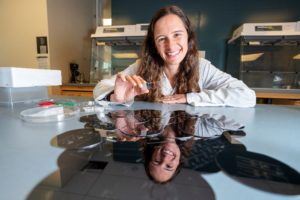Lab on a Chip is delighted to introduce our most recent Emerging Investigator, Katherine Elvira!
Katherine received her undergraduate Master’s degree in Chemistry from Imperial College London in 2007. She started working in the field of microfluidics during her PhD (2012, Imperial College London), by building digital microfluidic platforms to perform automated chemical reactions. Katherine then moved to ETH Zürich (Switzerland) working firstly as a Postdoctoral Researcher and then as a Senior Scientist in the Institute for Chemical and Bioengineering. Since 2017, Katherine is the Canada Research Chair in New Materials and Techniques for Health Applications and an Assistant Professor in the Department of Chemistry at the University of Victoria, Canada. Katherine’s group currently develops microfluidic technologies to build bespoke artificial cells for the quantification of pharmacokinetic parameters in vitro. Katherine has recently presented this work at the Gordon Research Conference on Drug Metabolism (2019), is Co-Chair for the Gordon Research Conference on the Physics and Chemistry of Microfluidics (2023) and is a Scientific Mentor for the Creative Destruction Lab.
Read Dr Elvira’s Emerging Investigator paper* “A bespoke microfluidic pharmacokinetic compartment model for drug absorption using artificial cell membranes” and find out more about her and her research in the interview below.
Image credit: UVic Photo Services
Your recent Emerging Investigator Series paper focuses on a new type of pharmacokinetic compartment model for the prediction of drug absorption. How has your research evolved from your first article to this most recent article?
Funnily enough, my first ever article was a very early precursor to this work. We built a microfluidic platform for the formation of droplet interface bilayers (DIBs) in high-throughput. I didn’t work with DIBs again until I started as a Canada Research Chair at the University of Victoria, but they are the basis for the new type of pharmacokinetic compartment model that we show in the Emerging Investigator article. We can now make them mimic human cell membranes and hence they form the building blocks for the compartments in the pharmacokinetic compartment model. In between, my research involved making microfluidic devices for application in many different fields, such as drug discovery, organic chemistry and food science. I also spent some time investigating why microfluidic droplets rarely behave perfectly, and how we can mitigate this. I like that paper because we included a poster in the ESI which my group still uses in the lab to determine what is going wrong with their chips.
What aspect of your work are you most excited about at the moment?
I am really excited about some cool new artificial cell and tissue models that we are building, and how they can be used to model disease and drug behaviour in humans. My group is full of outstanding researchers, which makes it really easy to be excited about the work they are doing!
In your opinion, what is the biggest advantage of using your microfluidic platform over other methods?
It’s two things, really. Firstly, the fact that we are able to build networks of different compartments and artificial cell membranes on a chip. This allows us to build an in vitro model of the pathway that a drug would take in a human, from the intestine to the blood. And secondly, the fact that we can make these artificial cell membranes using phospholipids that are found in human cells. This makes our in vitro model quite biomimetic. In fact, we are able to predict molecular transport into cells three times better than the state-of-the-art in vitro commercial technique.
What do you find most challenging about your research?
Let’s face it, PDMS is awesome in some ways, but awful in others. I would love to find another material that has the advantages of PDMS, such as being cheap, transparent, and good for prototyping, but that has really stable and modifiable surface chemistry, and that we can mass produce for commercial applications.
In which upcoming conferences or events may our readers meet you?
I am part of the Technical Program Committee for MicroTAS 2020, so I will be at the online conference in October. And next year I am co-Vice Chair of the Gordon Research Conference on the Physics and Chemistry of Microfluidics, which will hopefully be taking place in Italy.
How do you spend your spare time?
I am really lucky to live in beautiful British Columbia on the West coast of Canada. During the winter months I get to go backcountry snowboarding in some of the most outstanding mountains in the world. In the summer, I switch my snowboard for a stand-up paddle board along the beaches in Victoria. I also love travelling, which I do a lot, both for work and for fun. I need my yoga classes to keep me relaxed, and have a slight obsession with cooking all the European foods that I miss from home.
Which profession would you choose if you were not a scientist?
I wanted to be an astronaut when I was younger. It still sounds cool but I am also happy staying on earth and being an academic, it’s a pretty great life.
Can you share one piece of career-related advice or wisdom with other early career scientists?
I don’t always find it easy being a woman in science, so I would encourage early career female scientists to persevere, we need diversity in academia. I would tell their male colleagues to be good allies.
*Dr Elvira’s paper is free to access with an RSC account for the next month.











